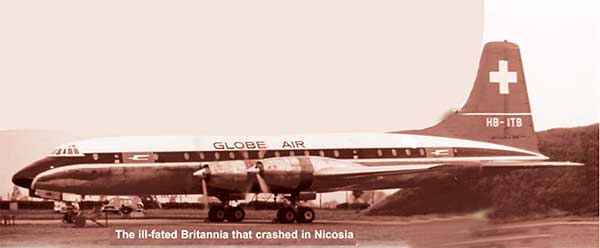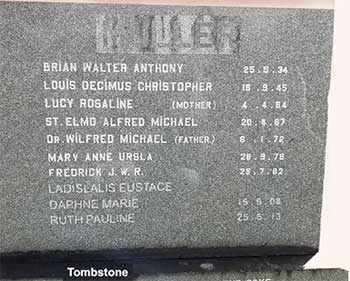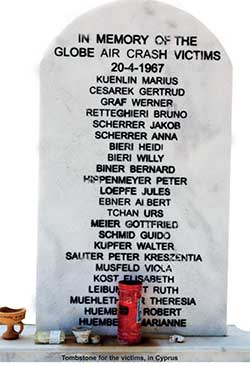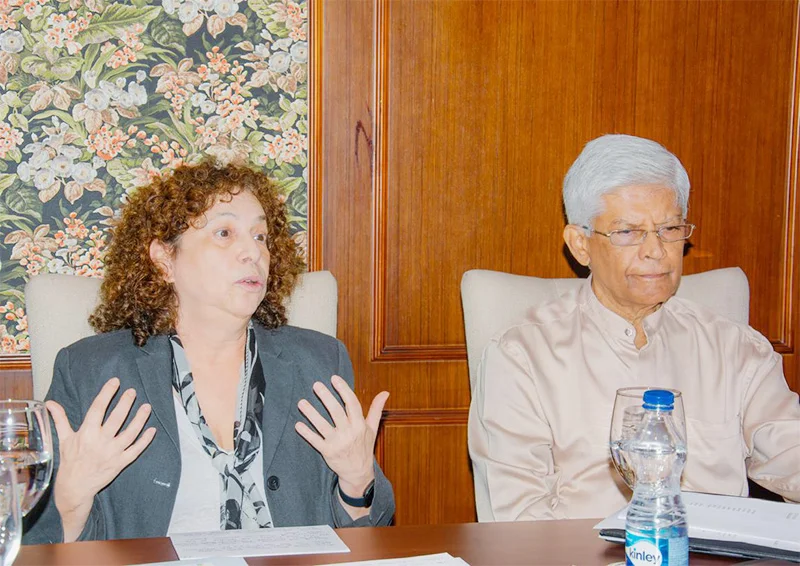Features
The Nicosia Tragedy – lest such be forgotten

 By Capt Elmo Jayawardena
By Capt Elmo Jayawardena
elmojay1@gmail.com
It was a lazy April morning in Bangkok’s Don Muang Airport. The Globe Air Charter flight carrying 120 Swiss and German passengers was about to taxi out for takeoff. The planned journey was long, starting in Thailand and ending up in Switzerland, with re-fueling stops in Colombo, Bombay and Cairo, before flying the last leg to its destination – Basel. The plane carried 10 crew – five in the cabin and five in the cockpit, comprising three pilots and two flight engineers, what they called a heavy crew to fly multi-sector long haul flights. In command was Capt. St Elmo Muller, a Ceylonese pilot who had served in the RAF during the second world war.
Capt. Muller was born in Colombo and educated at St. Joseph’s College. He learnt to fly as a teenager and obtained an ‘A’ licence at Ratmalana. They say that Muller used to cycle from Colombo to Ratmalana Airport to take his flying lessons from renowned flying instructor, Flight Lieutenant Robert Duncanson. Subsequently, Elmo Muller was one of the first 15 Ceylonese to join the Royal Air Force and leave for training to the UK. Four of the 15 were selected as fighter pilots and Elmo Muller trained to fly heavier bombers. He also flew reconnaissance Spitfires attached to Squadron 543 of the RAF. Having entered the RAF as a Sergeant Pilot he rose to the rank of Flight Lieutenant by 1945, when he was just 24 years of age. His quick rise through the ranks says much about Muller as an officer and a pilot.
After the war, Muller remained in Europe, flew charter aeroplanes for different companies, and served as a commercial pilot with EL AL, the national carrier of Israel.
 This was Capt. St Elmo Muller, aged 45, who took off from Bangkok on the19th of April 1967 – an experienced airman with 8285 flying hours, of which 1,493 were logged on Britannia aircraft. The co-pilot was P. Hippenmeyer, aged 24, a Swiss national, with a total of 1860 hours, of which 785 were on Britannia aeroplanes. The extra pilot – Capt. H. M. Day, a 40-year old DC-3 pilot, with 9,680 flying hours to his credit – was not rated on the Britannia, but may have been under training as he had 49 hours on this type. The three pilots together totalled almost 20,000 flying hours. Rated or not, there was a considerable amount of experience in that flight deck. As for the two flight engineers, H. W Saunders and H.J. Geisen, they both held valid Swiss Flight Engineer Licences endorsed to operate Britannias.
This was Capt. St Elmo Muller, aged 45, who took off from Bangkok on the19th of April 1967 – an experienced airman with 8285 flying hours, of which 1,493 were logged on Britannia aircraft. The co-pilot was P. Hippenmeyer, aged 24, a Swiss national, with a total of 1860 hours, of which 785 were on Britannia aeroplanes. The extra pilot – Capt. H. M. Day, a 40-year old DC-3 pilot, with 9,680 flying hours to his credit – was not rated on the Britannia, but may have been under training as he had 49 hours on this type. The three pilots together totalled almost 20,000 flying hours. Rated or not, there was a considerable amount of experience in that flight deck. As for the two flight engineers, H. W Saunders and H.J. Geisen, they both held valid Swiss Flight Engineer Licences endorsed to operate Britannias.
The aeroplane was a 10-year old Bristol Britannia powered by four Wright R-3350 turbo-compound engines. The Britannia was certainly the best British long range aeroplane at the time, fighting for its place among the Boeing Stratocruisers, Douglas DC-6s and the Lockheed Constellations that were built across the Atlantic. The Bristol Britannia was as good a plane as any, ranked alongside the best of aeroplanes until the jets, mainly 707s and DC-8s, took to the skies.
 The first sector from Bangkok was uneventful. They had five crew members who could swap places in the flight deck which needed three crew members to man. However, as pilot Day was not qualified on the type, whatever resting Capt. Muller did, needed to happen while seated at the Captain’s seat; not the best manner to rest, but a common practice among long haul operators. Doubtless, the journey from Bangkok to Basel, with its three mandatory stops, required great endurance from Capt. Muller. As for the others, they would have managed their in-flight rest periods to stay fresh and focused for the shifts they had to work.
The first sector from Bangkok was uneventful. They had five crew members who could swap places in the flight deck which needed three crew members to man. However, as pilot Day was not qualified on the type, whatever resting Capt. Muller did, needed to happen while seated at the Captain’s seat; not the best manner to rest, but a common practice among long haul operators. Doubtless, the journey from Bangkok to Basel, with its three mandatory stops, required great endurance from Capt. Muller. As for the others, they would have managed their in-flight rest periods to stay fresh and focused for the shifts they had to work.
Being late April with the South West monsoon active in Ceylon the Britannia would have landed on Runway (R/W) 22 in Colombo. The crew likely stretched their legs while the plane re-fueled, before setting off for Santa Cruz Airport in Bombay. That sector would have been the shortest in the flight plan and the easiest to fly. It was bright day light, and the track was over land with adequate navigational beacons for route corrections, dotted with en-route alternates across western India in case of an emergency.
By the time the Globe Air Britannia reached Bombay, they had flown two sectors of the four they were to fly and likely clocked over 10 hours of duty time. Duty time includes the 90 minutes of pre-flight preparation and another 30 – in some companies, 60 – minutes of post flight work.
Several factors influence the calculation of flight time and duty time. Suffice it to say that by the time they were to land in Cairo after the nine-hour leg from Bombay, the crew would have well exceeded their duty time limitations. However, this was an unscheduled charter, and it was 1967. It may not have been considered a mortal sin to stretch the limits of duty time. After all, they had five crew members to share the workload.
Departing Bombay, the Britannia took off with 11 hours and 10 minutes’ fuel endurance for the nine-hour flight. Capt. Muller headed west crossing the Arabian Sea to enter Omani Airspace. This was the longest leg of the trip – destination Cairo, the penultimate stop before Basel. I do not know the exact route they flew, but they would have flown over the Middle Eastern Emirates and Saudi Arabia, and past the Eastern Mediterranean to reach Cairo. By this time, the crew would have been on duty for over 20 hours and Capt. Muller, in command, would have been confined to his seat throughout except for his toilet breaks. That the crew was fatigued is doubtless; the limit for a present-day modern jet, flying a three-pilot operation, is around 12 hours.
As the Britannia approached Cairo, the weather gods played their Ace of Trumps. The airport was covered with thunderstorms and arriving pilots diverted to safe havens around the edge of the Mediterranean looking for alternates to land. Globe Air Britannia, after flying nine hours from Bombay, probably had approximately two hours of fuel left in the tanks when Capt. Muller made his decision to divert. The designated alternate for Globe Air was Beirut. The weather there was good – calm winds with one Okta (1/8th of the sky) of cumulus clouds. Cairo being equidistant from Beirut and Nicosia, just a little over 300 nautical miles, Capt. Muller opted to re-nominate Nicosia airport as his preferred alternate and headed to Cyprus.
Nicosia Airport was forecasting intermittent weather with thunderstorms. Capt Muller was no fool; he was a very experienced pilot. He must have had very good reasons for choosing Nicosia. The question remains unanswered why Capt. Muller did not divert to Beirut. I can only surmise, of course, that there might have been other aircraft diverting to Beirut from Cairo. The congestion may have been a reason why Capt. Muller decided to go to Nicosia as he could not have had the comfort of adequate fuel to go into a long holding pattern in Beirut.
There is no doubt that Capt. Muller made a professionally reasoned Commander’s decision to land in Nicosia. Given his experience and in the absence of evidence to the contrary, we can determine that the decision to go to Nicosia would have been made for very valid reasons. We must remember that a Captain diverting an aeroplane after a long flight may not have the luxury of time.
I do not know why the Britannia diverted to Nicosia. I will leave it at that. Let me get on with the story.
 At 2215 GMT, other aeroplanes in the area heard Globe Air calling Nicosia. Beirut heard it too and passed a message to Nicosia Control that Globe Air was making attempts to contact them. At 2300 Nicosia Approach talked to Globe Air and gave them the latest weather report. With 5/8 of the sky around the Nicosia aerodrome covered with thunderstorms, this was always going to be a difficult arrival. The airport did not have an Instrument Landing System (ILS) and was only fitted with a VOR for a non-precision approach. Globe Air came over the airfield at 2306 and was cleared for a right hand downwind to approach on R/W 32. At 2310 the Britannia reported it was over the R/W 32 threshold but as it was slightly high, the Captain executed a missed approach. The Tower then cleared Globe Air for a left-hand downwind circuit for R/W 32. Capt. Muller accepted the clearance and said he would fly a low-level visual circuit, doing his best to keep the runway in sight on his left.
At 2215 GMT, other aeroplanes in the area heard Globe Air calling Nicosia. Beirut heard it too and passed a message to Nicosia Control that Globe Air was making attempts to contact them. At 2300 Nicosia Approach talked to Globe Air and gave them the latest weather report. With 5/8 of the sky around the Nicosia aerodrome covered with thunderstorms, this was always going to be a difficult arrival. The airport did not have an Instrument Landing System (ILS) and was only fitted with a VOR for a non-precision approach. Globe Air came over the airfield at 2306 and was cleared for a right hand downwind to approach on R/W 32. At 2310 the Britannia reported it was over the R/W 32 threshold but as it was slightly high, the Captain executed a missed approach. The Tower then cleared Globe Air for a left-hand downwind circuit for R/W 32. Capt. Muller accepted the clearance and said he would fly a low-level visual circuit, doing his best to keep the runway in sight on his left.
The Swiss registered HB-ITB Britannia that Capt. Muller was flying did not have a Flight Recorder fitted. The airport did not have RADAR to track the path of the aeroplane. The only evidence available after the accident for investigations were the Air Traffic Control tapes, which recorded the communications between Globe Air and the Tower. The last message on tape was the pilot stating he was doing a low-level circuit. Sitting at my desk, more than fifty years later, I can only give careful consideration to all the circumstances and make an educated guess as to what happened next.
The Britannia was probably flying at 1000 feet, maybe 800 ft, on a left-hand downwind heading of 140 degrees. The dark midnight sky was covered with 5 oktas of thundery cumulonimbus, the visibility further reduced by rain. I picture Capt. Muller looking out of the left window to keep the runway in sight, as well as scanning his flight instruments to stay on track, speed and altitude. His fuel too may not have been much, as he started with 11 hours and 10 minutes from Bombay and burnt nine hours to get to Cairo. The diversion to Nicosia would have cost him another hour of fuel and the missed approach he executed in Nicosia may have burnt at least another 10 minutes of the precious little left. Capt. Muller was likely sitting on less than one hour’s worth of fuel when he was flying the low-level circuit: not enough to go anywhere except Nicosia.
In addition to all these calamitous facts, St Elmo Muller had sat on his Captain’s seat for more than 22 hours. If ever a deck was stacked against an Airline Captain, this was it.
45 seconds after passing the R/W 32 threshold, the Britannia commenced its left turn to the base leg heading of 050, which would have brought it perpendicular to R/W 32.
It was then, at 2313, that the left wing of the aeroplane hit the side of a hill at a height of 820 ft, 22 feet below the crest. The heading at point of impact was 068 degrees, the aircraft still turning to 050, the base leg heading. The wing broke and the aircraft rolled and hit another hillock, bursting into flames and killing 126 of the occupants. Almost impossibly, four survived, three of them severely injured. The fourth walked away from the crash without a scratch.
“The accident resulted from an attempt to make an approach at a height too low to clear rising ground.” That was the conclusion of the Nicosia Civil Aviation Authority after their investigation.
Without the information from a flight recorder it is difficult to know what really happened. The conclusions from different sources who were associated with the investigations are rather contradictory. As with most airline crashes, none of the flight crew lived to tell the tale.
Capt. St Elmo Muller’s remains were brought to Ceylon in a sealed coffin and placed in the Muller family vault at the Kanatte Cemetery.
I sincerely hope what I wrote would bring memories of an honourable Ceylonese aviator who should be remembered.
The truth of what happened on that fateful night remains lost forever on a Cypriot hill.
Features
SL urged to use GSP+ to the fullest to promote export development

 Sri Lanka needs to take full stock of its current economic situation and use to the maximum the potential in its GSP+ facility for export sector growth. In the process, it should ensure that it cooperates fully with the European Union. The urgency of undertaking these responsibilities is underscored by the issues growing out of the recent US decision to sweepingly hike tariffs on its imports, though differentially.
Sri Lanka needs to take full stock of its current economic situation and use to the maximum the potential in its GSP+ facility for export sector growth. In the process, it should ensure that it cooperates fully with the European Union. The urgency of undertaking these responsibilities is underscored by the issues growing out of the recent US decision to sweepingly hike tariffs on its imports, though differentially.
These were principal ‘takes’ for participants in the Pathfinder Foundation’s Ambassadors’ Roundtable forum held on April 8th at the Colombo Club of the Taj Samudra. The main presenter at the event was Ms. Carmen Moreno Raymundo, Ambassador of the European Union to Sri Lanka and the Maldives. The forum was chaired by Ambassador Bernard Goonetilleke, Chairman, Pathfinder Foundation. The event brought together a cross-section of the local public, including the media.
Ms. Moreno drew attention to the fact Sri Lanka is at present severely under utilizing its GSP+ facility, which is the main means for Sri Lanka to enter the very vast EU market of 450 million people. In fact the EU has been Sri Lanka’s biggest trading partner. In 2023, for instance, total trade between the partners stood at Euros 3.84 billion. There is no greater market but the EU region for Sri Lanka.
‘However, only Sri Lanka’s apparel sector has seen considerable growth over the years. It is the only export sector in Sri Lanka which could be said to be fully developed. However, wider ranging export growth is possible provided Sri Lanka exploits to the fullest the opportunities presented by GSP+.’
Moreno added, among other things: ‘Sri Lanka is one among only eight countries that have been granted the EU’s GSP+ facility. The wide-ranging export possibilities opened by the facility are waiting to be utilized. In the process, the country needs to participate in world trade in a dynamic way. It cannot opt for a closed economy. As long as economic vibrancy remains unachieved, Sri Lanka cannot enter into world trading arrangements from a strong position. Among other things, Sri Lanka must access the tools that will enable it to spot and make full use of export opportunities.
‘Sri Lanka must facilitate the private sector in a major way and make it possible for foreign investors to enter the local economy with no hassle and compete for local business opportunities unfettered. At present, Lanka lacks the relevant legal framework to make all this happen satisfactorily.
‘Sri Lanka cannot opt for what could be seen as opaque arrangements with bilateral economic partners. Transparency must be made to prevail in its dealings with investors and other relevant quarters. It’s the public good that must be ensured. The EU would like to see the local economy further opening up for foreign investment.
‘However, it is important that Sri Lanka cooperates with the EU in the latter’s efforts to bring about beneficial outcomes for Sri Lankans. Cooperation could be ensured by Sri Lanka fully abiding by the EU conditions that are attendant on the granting of GSP+. There are, for example, a number of commitments and international conventions that Sri Lanka signed up to and had promised to implement on its receipt of GSP+ which have hitherto not been complied with. Some of these relate to human rights and labour regulations.
‘Successive governments have pledged to implement these conventions but thus far nothing has happened by way of compliance. GSP+ must be seen as an opportunity and not a threat and by complying with EU conditions the best fruits could be reaped from GSP+. It is relevant to remember that GSP+ was granted to Sri Lanka in 2005. It was suspended five years later and restored in 2017.
‘The importance of compliance with EU conditions is greatly enhanced at present in view of the fact that Sri Lanka is currently being monitored by the EU with regard to compliance ahead of extending GSP+ next year. A report on Sri Lanka is due next year wherein the country’s performance with regard to cooperating with the EU would be assessed. The continuation of the facility depends on the degree of cooperation.
‘A few statistics would bear out the importance of Sri Lanka’s partnership with the EU. For example, under the facility Sri Lanka benefits from duty free access in over 66% of EU tariff lines. The highest number of tourist arrivals in Sri Lanka in 2023 was from the EU’s 27 member states. Likewise, the EU’s 27 member states rank second in the origin of inflows of foreign exchange to Sri Lanka; with Italy, France and Germany figuring as the main countries of origin. Eighty five percent of Sri Lanka’s exports to the EU market benefits from GSP+. Thus, the stakes for the country are high.’
Meanwhile, President, In-house Counsel & Legal Advisor, The European Chamber of Commerce of Sri Lanka, John Wilson said: ‘GSP+ should be seen as not only an opportunity but also as a necessity by Sri Lanka in the current international economic climate. ‘Implementation of local laws is what is needed. Considering the pressures growing out of the US imposed new tariff regime, a good dialogue with the EU is needed.
‘Sri Lanka’s level of business readiness must be upped. Among the imperatives are: An electronic procurement process, Customs reforms, a ‘National Single Window’, stepped-up access to land by investors, for example, a clear policy framework on PPPs and reform of the work permits system.’
It ought to be plain to see from the foregoing that Sri Lanka cannot afford to lose the GSP+ facility if it is stepped-up economic growth that is aimed at. It would be in Sri Lanka’s best interests to remain linked with the EU, considering the aggravated material hardships that could come in the wake of the imposition of the US’ new tariff regime. Sri Lanka would need to remain in a dialogue process with the EU, voice its reservations on matters growing out of GSP+, if any, iron out differences and ensure that its national interest is secured.
Features
SENSITIVE AND PASSIONATE…

Chit-Chat
Chiara Tissera
Mrs. Queen of the World Sri Lanka 2024, Chiara Tissera, leaves for the finals, in the USA, next month
I had a very interesting chat with her and this is how it all went:
1. How would you describe yourself?
I am a sensitive and passionate individual who deeply cares about the things that matter most to me. I approach life with a heart full of enthusiasm and a desire to make meaningful connections.
2. If you could change one thing about yourself, what would it be?
Actually, I wouldn’t change a thing about myself because the person I am today, both inside and out, is the result of everything I’ve experienced. Every part of me has shaped who I am, so I embrace both my strengths and imperfections as they make me uniquely me.
3. If you could change one thing about your family, what would it be?
If there’s one thing I could change about my family, it would be having my father back with us. Losing him six years ago left a void that can never be filled, but his memory continues to guide and inspire us every day.
4. School?
I went to St. Jude’s College, Kurana, and I’m really proud to say that the lessons I gained during my time there have shaped who I am today. My school and teachers instilled in me values of hard work, perseverance and the importance of community, and I carry those lessons with me every day. I was a senior prefect and was selected the Deputy Head Prefect of our college during my tenure.
5. Happiest moment?
The happiest moment of my life so far has been winning the Mrs. Sri Lanka 2024 for Queen of the World. It was a dream come true and a truly unforgettable experience, one that fills me with pride and gratitude every time I reflect on it.
6. What is your idea of perfect happiness?
Happiness is a deeply personal and multifaceted feeling that often comes from a sense of contentment, fulfillment and well-being. For me, perfect happiness is in moments of joy, peace and accomplishments … and also being surrounded by my loved ones.
7. Are you religious?
Yes, I’m a very religious person. And I’m a firm believer in God. My faith guides me through life, providing strength, dedication and a sense of peace in every situation. I live by the quote, ‘Do your best, and God will do the rest.’
8. Are you superstitious?
I’m not superstitious. I believe in making my own decisions and relying on logic and faith rather than following superstitions.
9. Your ideal guy?
My ideal guy is my husband. He is compassionate, understanding and is always there to support me, no matter what. He’s my rock and my best friend – truly everything I could ever want in a partner.
10. Which living person do you most admire?
The living person I admire the most is definitely my mummy. Her strength, love and unwavering support has shaped me into who I am today. She is my role model and she inspires me every day with her wisdom and kindness.
11. Your most treasured possession?
My most treasured possession is my family. They are the heart of my life, providing me with love, support and strength. Their presence is my greatest blessing.
12. If you were marooned on a desert island, who would you like as your companion?
I would like to have my spouse as my companion. Together, we could make the best of the situation, supporting each other, sharing moments of laughter and finding creative ways to survive and thrive.
13. Your most embarrassing moment?
There’s quite a few, for sure, but nothing is really coming to mind right now.
14. Done anything daring?
Yes, stepping out of my comfort zone and taking part in a pageant. I had no experience and was nervous about putting myself out there, but I decided to challenge myself and go for it. It pushed me to grow in so many ways—learning to embrace confidence, handle pressure, and appreciate my own uniqueness. The experience not only boosted my self-esteem but also taught me the value of taking risks and embracing new opportunities, even when they feel intimidating.”
15. Your ideal vacation?
It would be to Paris. The city has such a magical vibe and, of course, exploring the magical Eiffel Tower is in my bucket list. Especially the city being a mix of history culture and modern life in a way that feels timeless, I find it to be the ideal vacation spot for me.
16. What kind of music are you into?
I love romantic songs. I’m drawn to its emotional depth and the way they express love, longing a connection. Whether it’s a slow ballad, a classic love song or a more modern romantic tune these songs speak to my heart.
17. Favourite radio station?
I don’t have a specific radio station that I like, but I tend to enjoy a variety of stations, depending on my mood. Sometimes I’ll tune into one for a mix of popular hits, other times I might go for something more relaxing, or a station with a certain vibe. So I just like to keep it flexible and switch it up.
18. Favourite TV station?
I hardly find the time to sit down and watch TV. But, whenever I do find a little spare time, I tend to do some spontaneous binge – watching, catching whatever interesting show is on at that moment.
19 What would you like to be born as in your next life?
Mmmm, I’ve actually not thought about it, but I’d love to be born as someone who gets to explore the world freely – perhaps a bird soaring across continents.
20. Any major plans for the future?
Let’s say preparing and participating in the international pageant happening in the USA this May. It’s an exciting opportunity to represent myself and my country on a global stage. Alongside this, I am dedicated to continuing my social service work as a title holder, striving to make a meaningful difference in the lives of others through my platform.
Features
Fresher looking skin …

 The formation of wrinkles and fine lines is part of our ageing process. However, if these wrinkles negatively impact appearance, making one look older than they actually are, then trying out some homemade remedies, I’ve listed for you, this week, may help in giving your skin a fresher look.
The formation of wrinkles and fine lines is part of our ageing process. However, if these wrinkles negatively impact appearance, making one look older than they actually are, then trying out some homemade remedies, I’ve listed for you, this week, may help in giving your skin a fresher look.
* Banana:
Bananas are considered to be our skin’s best friend. They contain natural oils and vitamins that work very perfectly to boost our skin health. Skincare experts recommend applying the banana paste to the skin.
Take a ripe banana and mash a quarter of it until it becomes a smooth paste. Apply a thin layer of the banana paste on your skin and allow it to sit for 15 to 20 minutes before washing it off with warm water.
* Olive Oil:
Olive oil works as a great skin protector and many types of research suggest that even consuming olive oil may protect the skin from developing more wrinkles. Olive oil contains compounds that can increase the skin’s collagen levels. Yes, olive oil can be used as a dressing on your salads, or other food, if you want to consume it, otherwise, you can apply a thin layer of olive oil on your face, neck and hands and let it stay overnight.
* Ginger:
Ginger serves to be a brilliant anti-wrinkle remedy because of the high content of antioxidants in it. Ginger helps in breaking down elastin, which is one of the main reasons for wrinkles. You can have ginger tea or grate ginger and have it with honey, on a regular basis.
* Aloe Vera:
The malic acid present in Aloe Vera helps in improving your skin’s elasticity, which helps in reducing your wrinkles. Apply the gel once you extract it from the plant, and leave it on for 15-20 minutes. You can wash it off with warm water.
* Lemons:
Lemons contain citric acid, which is a strong exfoliant that can help you get rid of your dead skin cells and wrinkles. Also, as an astringent and a cleansing agent, it helps to fade your wrinkles and fine lines. You can gently rub a lemon slice in your wrinkled skin and leave it on for 10-15 minutes. Rinse afterwards and repeat this process two to three times a day.
* Coconut Oil:
Coconut oil contains essential fatty acid that moisturises the skin and helps to retain its elasticity. You can directly apply the coconut oil, and leave it overnight, after gently massaging it, for the best results.
-

 Business3 days ago
Business3 days agoColombo Coffee wins coveted management awards
-

 Business5 days ago
Business5 days agoDaraz Sri Lanka ushers in the New Year with 4.4 Avurudu Wasi Pro Max – Sri Lanka’s biggest online Avurudu sale
-

 Features4 days ago
Features4 days agoStarlink in the Global South
-

 Business6 days ago
Business6 days agoStrengthening SDG integration into provincial planning and development process
-

 Business5 days ago
Business5 days agoNew SL Sovereign Bonds win foreign investor confidence
-

 Features1 day ago
Features1 day agoSri Lanka’s Foreign Policy amid Geopolitical Transformations: 1990-2024 – Part III
-

 Features4 days ago
Features4 days agoModi’s Sri Lanka Sojourn
-

 Midweek Review1 day ago
Midweek Review1 day agoInequality is killing the Middle Class











